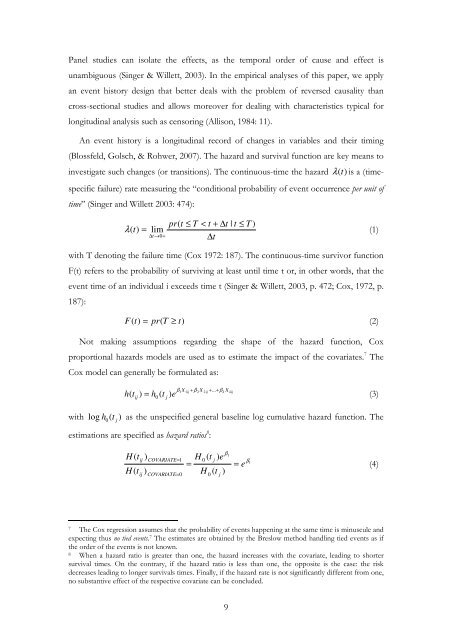for a German is coded as having one or more friends that have another nationality thanGerman. Intra-ethnic ties are coded inversely: for <strong>native</strong> <strong>Germans</strong>, these are friendshipswith German nationals; for Turks these are friendships with people not having theGerman nationality. 4 We include the friendships as a dummy rather than a count, sincethe most important difference is between having a friendship <strong>and</strong> not having afriendship, rather than an interval scale of friendships assuming equal distances betweenthe categories (following Van der Gaag & Snijders, 2004). 5Control variablesEducational attainment was operationalised according to the ISCED scheme with thefollowing categories: (1) Inadequately, (2) General Elementary, (3) Middle Vocational, (4)Vocational plus Abitur (A levels), (5) Higher Vocational Education, <strong>and</strong> (6) HigherEducation (UNESCO, 1997). For the analysis, (1) <strong>and</strong> (2) as well as (4) <strong>and</strong> (5) werecollapsed into one category respectively. In addition, we control for language proficiency 6<strong>and</strong> language proficiency squared, gender, age <strong>and</strong> age squared. Last, we include threedummies to control for differences among the observed survey years (1996-1999, 2000-2003, <strong>and</strong> 2004-2006).Method of estimationMany studies that analyze the returns of social capital suffer from an endogeneityproblem, since the direction of the association between labour market outcomes <strong>and</strong>social capital is not clear (compare Mouw, 2002; Offe & Fuchs, 2004). Both theoreticalarguments are plausible: on the one h<strong>and</strong>, social capital may contribute to economicsuccess, but economic participation may on the other h<strong>and</strong> also enhance social capital.4 This is the category‚ ‚other nationality’. We checked with the follow-up question ‚Do you come fromthe same country?’ whether these ties are indeed intra-ethnic. This appeared to be the case: in 97percent ofthe cases that Turks indicate that their friend has another nationality than German, this friend is also of<strong>Turkish</strong> origin.5 Applying a longitudinal design, the explanatory variable, i.e. social capital, is measured before the event.This on the other h<strong>and</strong> led in a number of cases to a considerable delay between both points of time oreven to missing values.6 The measure of language proficiency consists of a scale containing three items, measured in 1997, 1999,2001, 2003, 2005. The items included are ‚Own opinion of spoken German’, Own opinion of writtenGerman’, Language usually spoken (German, mostly that of country of origin, equally). Reliability analysis(Alpha varies between waves from .83 until .86) as well as cumulative scaling with Mokken analysis(Loevinger H varies from .74 to .79 between waves) show that these items can be seen as a singleconstruct. The <strong>native</strong> <strong>Germans</strong> did not receive the language items, <strong>and</strong> are therefore given the highestvalue on the scale.8
Panel studies can isolate the effects, as the temporal order of cause <strong>and</strong> effect isunambiguous (Singer & Willett, 2003). In the empirical analyses of this paper, we applyan event history design that better deals with the problem of reversed causality thancross-sectional studies <strong>and</strong> allows moreover for dealing with characteristics typical forlongitudinal analysis such as censoring (Allison, 1984: 11).An event history is a longitudinal record of changes in variables <strong>and</strong> their timing(Blossfeld, Golsch, & Rohwer, 2007). The hazard <strong>and</strong> survival function are key means toinvestigate such changes (or transitions). The continuous-time the hazard λ(t)is a (timespecificfailure) rate measuring the “conditional probability of event occurrence per unit oftime” (Singer <strong>and</strong> Willett 2003: 474):pr(t ≤ T < t + ∆t| t ≤ T )λ ( t)= lim(1)∆t→0+∆twith T denoting the failure time (Cox 1972: 187). The continuous-time survivor functionF(t) refers to the probability of surviving at least until time t or, in other words, that theevent time of an individual i exceeds time t (Singer & Willett, 2003, p. 472; Cox, 1972, p.187):F( t)= pr(T ≥ t)(2)Not making assumptions regarding the shape of the hazard function, Coxproportional hazards models are used as to estimate the impact of the covariates. 7 TheCox model can generally be formulated as:ijj1X1ij+2 X 2ij+ ...β β + βk X kijh( t ) = h ( t ) e(3)0with log h 0( t j) as the unspecified general baseline log cumulative hazard function. Theestimations are specified as hazard ratios 8 :H ( tH(tijij))β1COVARIATE=1 0 jβCOVARIATE=0H ( t ) e=H ( t )0j= e1(4)7 The Cox regression assumes that the probability of events happening at the same time is minuscule <strong>and</strong>expecting thus no tied events. 7 The estimates are obtained by the Breslow method h<strong>and</strong>ling tied events as ifthe order of the events is not known.8 When a hazard ratio is greater than one, the hazard increases with the covariate, leading to shortersurvival times. On the contrary, if the hazard ratio is less than one, the opposite is the case: the riskdecreases leading to longer survivals times. Finally, if the hazard rate is not significantly different from one,no substantive effect of the respective covariate can be concluded.9


